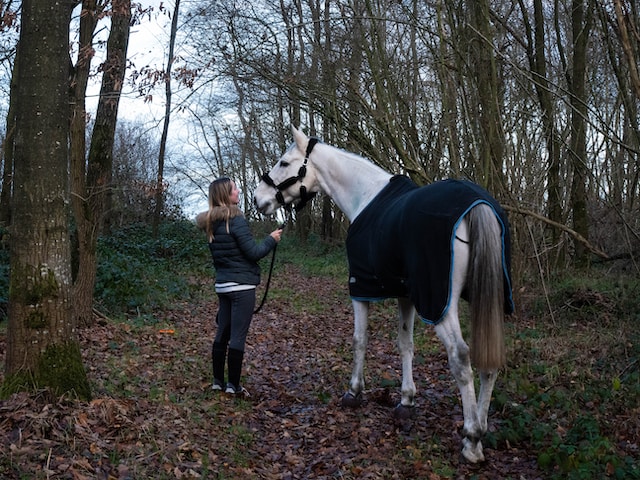
If you’re seeking a transformative and unique approach to therapy, consider the inviting world of Equine Assisted Therapy (EAT). In this therapeutic journey, you’ll step into a realm where horses become your trusted companions, guides, and mirrors of your inner world. Equine Assisted Therapy offers a dynamic and experiential path to healing, personal growth, and self-discovery.
Whether you’re navigating emotional challenges, seeking to improve your relationships, or simply yearning for a profound connection with these majestic animals, EAT invites you to embark on a therapeutic adventure like no other. Explore how the presence of these gentle giants can empower you to find solace, insight, and transformation on your path to well-being and self-understanding.
Find a therapist.

What is Equine Assisted Therapy?
Equine Assisted Therapy (EAT), also known as Equine Assisted Psychotherapy (EAP), is a therapeutic approach that involves interactions between individuals and horses as a means of addressing various emotional, psychological, and behavioral challenges. In equine-assisted therapy sessions, individuals engage in activities with horses, such as grooming, leading, or riding, under the guidance of trained therapists or facilitators. The interactions with horses are carefully structured to promote emotional and psychological growth and healing.
Why Horses Can Help Us Heal
Horses are highly sensitive animals, and their responses to human interactions can provide valuable insights into a person’s emotional state and relational patterns. Equine Assisted Therapy is not about horsemanship but rather uses the horse as a therapeutic partner to help individuals explore and process their emotions, develop self-awareness, improve communication and interpersonal skills, and address specific therapeutic goals.
Equine Assisted Therapy and Other Animal-Assisted Therapy
Equine Assisted Therapy (EAT) shares similarities with other types of Animal Assisted Therapy (AAT) but also exhibits distinct differences, primarily based on the choice of animal and the therapeutic approach.
Both EAT and AAT involve structured interactions with animals to enhance the therapeutic process. These animals, whether horses, dogs, cats, or others, serve as essential co-therapists or facilitators in the therapeutic journey. The presence of animals often fosters emotional connections, trust, and feelings of safety, which create a supportive environment for individuals to explore their emotions and heal. Additionally, animals communicate primarily through non-verbal cues, encouraging individuals to become more attuned to body language, emotions, and energetic interactions. This non-verbal communication aspect is a shared feature in both EAT and other AAT modalities.
However, in addition to using different animals, the therapeutic goals and approaches may also differ, with EAT often focusing on experiential learning, personal growth, and self-awareness, while other AAT modalities may target specific issues, such as social skills, emotional regulation, or behavioral challenges. Additionally, the setting for EAT sessions is frequently outdoors or in equine facilities, while other AAT modalities can take place indoors or in various settings, depending on the chosen animal.
Benefits of Equine Assisted Therapy
Just a few of the common benefits of Equine Assisted Therapy include:
Emotional Regulation and Self-Awareness
Interactions with horses can help individuals become more attuned to their own emotions and body sensations. Horses are highly sensitive to emotional cues, and their reactions provide immediate feedback. This can be especially helpful for individuals who struggle with emotional regulation, such as those dealing with anger, anxiety, or mood disorders.
Building Trust and Establishing Boundaries
Developing a relationship with a horse requires trust and clear communication. In EAT, individuals learn to build trust and establish boundaries, which can be transferable to personal relationships. This is valuable for individuals with trust issues, history of trauma, or difficulties in forming healthy boundaries.
Non-Verbal Communication
Equine Assisted Therapy relies heavily on non-verbal communication with horses. This can be particularly beneficial for individuals who find it challenging to express themselves verbally or struggle with social interactions. It offers a unique opportunity to improve non-verbal communication skills.
Family and Relationship Dynamics
Equine Assisted Therapy can be used for family therapy, helping families improve communication, resolve conflicts, and strengthen their bonds. It offers a unique and non-confrontational way to address relationship dynamics.
Stress Reduction
The calming presence of horses and the tranquil outdoor environment in which Equine Assisted Therapy often takes place can reduce stress and promote relaxation. This is beneficial for individuals dealing with stress-related disorders, including anxiety, PTSD, and burnout.
Building Self-Esteem and Confidence
Accomplishing tasks with horses, such as grooming or leading, can boost self-esteem and self-confidence. This is valuable for individuals with low self-esteem, especially children and adolescents.
Mindfulness and Present-Moment Awareness
Interacting with horses encourages mindfulness and present-moment awareness. This can benefit individuals who are seeking to be more present, reduce rumination, and manage symptoms related to conditions like depression and ADHD.
Who Benefits from Equine Assisted Therapy
Equine Assisted Therapy can be particularly beneficial for individuals dealing with a wide range of challenges, including trauma, anxiety, depression, ADHD, autism spectrum disorders, addiction, eating disorders, and relationship difficulties. The presence of horses and the therapeutic activities involving them create a unique and non-judgmental environment for self-discovery and personal growth.
Trauma
Equine Assisted Therapy offers a unique platform for trauma healing. Horses’ sensitivity to emotions enables individuals to develop emotional regulation skills in a supportive environment. Moreover, EAT employs somatic experiences to process trauma, acknowledging that trauma often resides in the body. Trust building is another key aspect, as forming connections with horses helps individuals rebuild trust, which can be especially valuable for trauma survivors.
Anxiety and Depression
Equine Assisted Therapy encourages mindfulness and present-moment awareness, making it effective in reducing symptoms related to anxiety and depression. The tranquil outdoor setting and interactions with horses naturally reduce stress and boost mood, contributing to overall emotional well-being.
ADHD
Individuals with ADHD benefit from improved focus during Equine Assisted Therapy sessions. Working with horses requires attention to detail and concentration, skills that can be transferred to other aspects of life. Additionally, the physical activity involved in EAT helps individuals with ADHD in expending excess energy.
Autism Spectrum Disorders
EAT provides sensory-rich experiences that can enhance sensory integration and self-regulation in individuals with autism. Moreover, interactions with horses improve non-verbal communication skills, an area of challenge for some individuals with autism.
Addiction
Equine Assisted Therapy assists individuals in developing healthier coping mechanisms to replace addictive behaviors. It also offers opportunities for self-reflection, aiding in the identification and resolution of underlying emotional issues contributing to addiction.
Eating Disorders
Equine Assisted Therapy promotes body positivity and self-acceptance through interactions with horses and mindful self-reflection. Additionally, it helps individuals address emotional issues associated with eating disorders, as these often underlie disordered eating behaviors.
Equine Assisted Therapy enhances communication and relationship skills through interactions with horses, skills that can be transferred to personal relationships. Furthermore, trust-building and the establishment of healthy boundaries are integral components, fostering improved relationship dynamics.
Grief and Loss
Equine Assisted Therapy (EAT) offers a unique and compassionate approach to addressing grief and loss. Through interactions with horses, individuals can express and process their complex emotions, often difficult to convey verbally. The somatic nature of EAT acknowledges the physical manifestations of grief, allowing individuals to release tension and pain stored in their bodies. Additionally, the metaphorical reflections provided by horses enable individuals to gain insights and find meaning in their grief journey, while the trust-building and connection with these sensitive animals can help rebuild trust and forge new connections during a period of loss and isolation.
EAT also provides opportunities for rituals and closure, allowing individuals to honor and remember their loved ones in meaningful ways. These experiences, often facilitated in group settings, foster a sense of support and empathy within a community of individuals sharing similar grief experiences. Overall, equine therapy contributes to emotional resilience, helping individuals gradually transition from grief to a place of emotional strength and acceptance while preserving the memory of their loved ones.
Equine Assisted Therapy in Combination With Other Therapy Types
Equine Assisted Therapy (EAT) is often integrated with other therapy types to create a comprehensive and tailored approach to addressing various psychological and emotional challenges. Here are some ways in which EAT can complement other therapy modalities:
Cognitive Behavioral Therapy (CBT)
Equine Assisted Therapy can be combined with CBT to help individuals challenge and reframe negative thought patterns and behaviors. Interacting with horses can provide real-life situations for practicing cognitive restructuring and emotional regulation.
Trauma-Informed Therapy
For clients with a history of trauma, Equine Assisted Therapy can complement trauma-informed therapy by offering a safe environment for processing traumatic experiences and addressing triggers. The non-verbal nature of EAT can be especially valuable when words are inadequate for expressing trauma.
Somatic Experiencing
Equine Assisted Therapy aligns well with somatic therapies, such as Somatic Experiencing, as both emphasize the mind-body connection. Working with horses can help individuals become more attuned to their body sensations and trauma responses, facilitating healing at a physical level.
Attachment-Based Therapy
Equine Assisted Therapy can enhance attachment-based therapy by providing opportunities to explore attachment dynamics in a non-threatening and experiential manner. Building trust and emotional connections with horses can parallel the therapeutic work of building secure attachments.
Expressive Arts Therapy
Combining Equine Assisted Therapy with expressive arts therapy, like art or music therapy, can offer multiple creative avenues for individuals to express and process their emotions. This integration can be particularly beneficial for those who find it challenging to communicate verbally.
Family Therapy
Equine Assisted Therapy can be a valuable component of family therapy sessions, helping family members improve communication, build trust, and work through relational challenges. Interacting with horses as a family can foster collaboration and understanding.
Mindfulness-Based Therapies
Equine Assisted Therapy aligns with mindfulness-based therapies by promoting present-moment awareness and mindful interactions with the environment and horses. These skills can be integrated into mindfulness practices outside of EAT sessions.
Gestalt Therapy
Equine Assisted Therapy can support Gestalt therapy’s focus on self-awareness and self-acceptance. The experiential nature of EAT allows individuals to explore unfinished business and gain insights into their relational patterns.
Existential Therapy
In existential therapy, Equine Assisted Therapy can help clients confront questions about the meaning of life and their existence. Interactions with horses and nature can provide a serene backdrop for exploring existential concerns.
Transpersonal Therapy
Equine Assisted Therapy can be integrated into transpersonal therapy to facilitate spiritual exploration and self-discovery. Some individuals may find a sense of transcendence and connectedness with nature and horses during EAT sessions.
Next Steps:
Equine Assisted Therapy’s success in addressing challenges is due to its experiential nature, emphasis on non-verbal communication, and the therapeutic qualities of the equine-human relationship. However, it’s essential to remember that the effectiveness of Equine Assisted Therapy depends on the individual, the therapist’s expertise, and the specific goals of therapy.
Are you ready to find a therapist who specializes in equine assisted therapy? Search our therapist directory today to find the one who is right for you. Or call us for more information.







